India’s Fusion Energy Roadmap
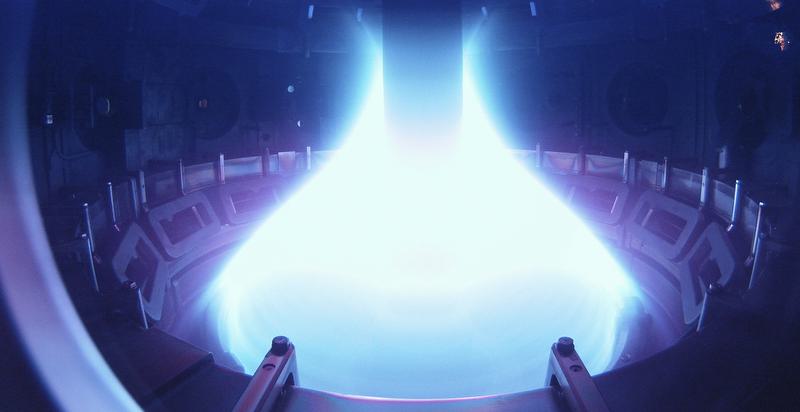
- 28 Sep 2025
In News:
- Researchers at the Institute for Plasma Research (IPR), Gandhinagar, have unveiled a comprehensive roadmap for India’s fusion energy programme.
- This initiative aims to develop the country’s first fusion electricity generator, Steady-state Superconducting Tokamak–Bharat (SST-Bharat), and ultimately commission a demonstration reactor by 2060.
- The roadmap signifies a major step in India’s pursuit of sustainable, high-yield, and low-waste energy alternatives.
Understanding Nuclear Fusion
Nuclear fusion is the process where two light atomic nuclei (like isotopes of hydrogen) merge to form a heavier nucleus, releasing immense energy—similar to the reactions that power the Sun.
It differs from nuclear fission, where heavy atoms split apart to release energy.
Advantages of Fusion over Fission
- Minimal radioactive waste and no long-term storage challenges.
- Abundant fuel sources (deuterium from water, tritium from lithium).
- No greenhouse gas emissions and no meltdown risk.
- High energy density, offering a virtually limitless energy source.
India’s Current Fusion Research Base
- SST-1 Tokamak (IPR, Gandhinagar): India’s first steady-state superconducting tokamak, designed for plasma research. It has achieved plasma duration of ~650 milliseconds, with potential to reach 16 minutes.
- Participation in ITER (France): India contributes technology, components, and funding to the International Thermonuclear Experimental Reactor (ITER), the world’s largest magnetic confinement experiment aimed at demonstrating a Q-value (output/input ratio) of 10.
India’s Fusion Power Roadmap
1. The SST-Bharat Project
- A fusion-fission hybrid reactor proposed as India’s next major milestone.
- Expected output: 130 MW (100 MW from fission, 30 MW from fusion).
- Estimated cost: ?25,000 crore.
- Efficiency target: Five times the input power.
- Acts as a bridge technology toward achieving pure fusion energy.
2. Demonstration Reactor (By 2060)
- Planned 250 MW full-scale reactor.
- Target Q-value: 20 (i.e., producing 20 times more energy than input).
- Will use magnetic confinement, heating plasma to over 100 million°C — much hotter than the Sun’s core (15 million°C).
Technological Innovations Proposed
- Digital Twinning: Creating virtual replicas of tokamak systems to test and optimise operations before physical construction.
- Machine Learning-Assisted Plasma Control: Using AI for real-time monitoring and stability of plasma.
- Radiation-Resistant Materials: Essential for reactor longevity and safety.
- Superconducting Magnet Development: To maintain continuous plasma confinement efficiently.
Global Benchmarks and India’s Position
|
Country/Programme |
Reactor/Initiative |
Target Year |
Notable Achievement |
|
UK |
STEP Programme |
2040 |
Prototype fusion power plant planned |
|
USA |
Private Start-ups |
2030s |
Early grid-connected fusion target |
|
China |
EAST Tokamak |
Ongoing |
Record plasma duration |
|
France |
WEST Tokamak |
2025 |
Maintained plasma for 22 minutes |
|
India |
SST-Bharat & Demo Reactor |
2060 |
Gradual, state-led development path |
While global players pursue faster timelines, India’s approach is cautious but strategic, focused on self-reliance and steady technological progress.
Challenges in India’s Fusion Path
Technological
- Sustaining stable plasma for long durations.
- Achieving Q > 1 (self-sustaining fusion).
- Developing durable superconducting magnets and radiation-resistant materials.
Financial
- High costs: SST-Bharat alone costs ?25,000 crore.
- Competing priorities: Solar, wind, and fission projects receive higher funding.
- Limited private-sector participation compared to global trends.
Policy and Governance
- Absence of a dedicated fusion energy regulatory framework.
- Need for integrated policy support under India’s Net Zero 2070 commitments.
Economic Viability
Experts like M.V. Ramana (University of British Columbia) caution that commercial fusion power remains economically unproven, and timelines are often optimistic. High R&D and construction costs could make fusion electricity expensive compared to renewables.
Strategic and Technological Significance
Even if commercial viability takes time, fusion R&D brings collateral benefits:
- Advances in plasma physics, superconducting technology, and high-temperature materials.
- Development of radiation-hardened components for defence, space, and nuclear industries.
- Strengthened technological autonomy and enhanced participation in global research networks.
India Green Energy Paradox
- 07 Sep 2025
In News:
India’s energy sector is witnessing a paradoxical challenge: while 44 GW of renewable energy (RE) capacity is ready for deployment, it remains stranded due to lack of Power Purchase Agreements (PPAs), weak demand absorption, and systemic barriers. This “green energy paradox” highlights the tension between India’s global climate commitments and its domestic energy realities.
Current Energy Landscape
Despite global recognition for its renewable push, India’s energy mix remains heavily dependent on coal:
- Coal & lignite: ~79% of domestic energy (FY23).
- Renewables (excluding large hydro): Only 3.8% of domestic production.
- Oil & gas imports: Over 85% oil and 50% gas, making India highly import-dependent.
While renewable capacity is expanding, India continues to lock itself into long-term coal PPAs, raising both environmental and economic concerns.
Green Energy Paradox: Two Dimensions
1. Supply-Side Readiness
- 44 GW of RE projects are deployment-ready but idle without PPAs.
- Tariff challenges: Solar power in India remains costlier than global benchmarks due to high cost of capital, GST, duties, and import taxes.
- Storage costs: Storage-backed renewables (battery/pumped hydro) raise tariffs to ?6.6–?9/unit, making them uncompetitive against coal.
- Government interventions: Initiatives like the National Solar Mission, Hybrid Policy, Production-Linked Incentive (PLI) for batteries, and Viability Gap Funding (VGF) aim to reduce costs and promote adoption.
2. Demand-Side Weaknesses
- Discom reluctance: Financially stressed state distribution companies (discoms) prefer coal PPAs due to predictable pricing.
- Grid inflexibility: Poor transmission capacity, absence of smart meters, and weak demand-response systems hinder RE integration.
- Slow electrification: With electricity accounting for just 20% of India’s total energy consumption (vs. 28% in China), limited adoption of EVs, electric cooking, and industrial heating suppresses RE demand.
- Reliability deficit: India’s System Average Interruption Duration Index (SAIDI) stands at 600 minutes/year, compared to 35 minutes in Thailand and 46 in Malaysia, deterring energy-intensive industries.
Barriers to Integration
- Structural: Debt-ridden discoms, weak cross-subsidy frameworks, and lack of flexible grids.
- Economic: High capital costs, expensive borrowing, and unviable storage solutions.
- Environmental: Long-term coal lock-ins undermine India’s Net Zero 2070 goals, while idle RE capacity delays emissions reduction.
Initiatives Taken
- Renewable Purchase Obligations (RPOs): Mandate states to procure RE, though targets often clash with local grid capability.
- Green Open Access Rules (2022): Allow industries to directly purchase renewable power, bypassing discoms.
- National Green Hydrogen Mission: Positions hydrogen as a long-term storage solution and clean fuel.
- PLI for batteries and India Semiconductor Mission: Support indigenous storage manufacturing.
PM Surya Ghar: Muft Bijli Yojana
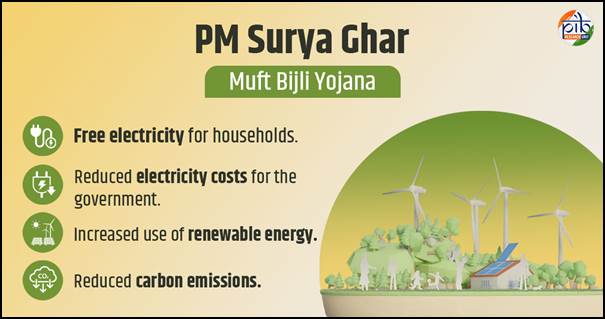
- 06 Dec 2024
In News:
The PM Surya Ghar: Muft Bijli Yojana, the world’s largest domestic rooftop solar initiative, is transforming India’s energy landscape with a bold vision to supply solar power to one crore households by March 2027.
Key Details:
Targeted Installations:
- 10 lakh installations by March 2025.
- 1 crore installations by March 2027.
Subsidy and Financing:
- Offers up to 40% subsidy for rooftop solar installations based on household electricity consumption.
- Collateral-free loans available for up to 3 kW solar systems at a 7% interest rate.
Key Benefits:
The PM Surya Ghar: Muft Bijli Yojana offers several significant benefits to participating households:
- Free Electricity for Households: The scheme provides households with free electricity through the installation of subsidized rooftop solar panels, significantly reducing their energy costs.
- Reduced Electricity Costs for the Government: By promoting the widespread use of solar power, the scheme is expected to save the government an estimated ?75,000 crore annually in electricity costs.
- Increased Use of Renewable Energy: The scheme encourages the adoption of renewable energy sources, contributing to a more sustainable and environmentally friendly energy mix in India.
- Reduced Carbon Emissions: The transition to solar energy under this scheme will help lower carbon emissions, supporting India's commitment to reducing its carbon footprint.
Eligibility Criteria:
1. The applicant must be an Indian citizen.
2. Must own a house with a roof that is suitable for installing solar panels.
3. The household must have a valid electricity connection.
4. The household must not have availed of any other subsidy for solar panels.
Impact
The PM Surya Ghar: Muft Bijli Yojana is expected to have far-reaching outcomes, both for individual households and the nation as a whole:
- Household Savings and Income Generation: Households will benefit from significant savings on their electricity bills. Additionally, they will have the opportunity to earn extra income by selling surplus power generated by their rooftop solar systems to DISCOMs. For instance, a 3-kW system can generate over 300 units per month on average, providing a reliable source of energy and potential revenue.
- Expansion of Solar Capacity: The scheme is projected to add 30 GW of solar capacity through rooftop installations in the residential sector, significantly contributing to India's renewable energy goals.
- Environmental Benefits: Over the 25-year lifetime of these rooftop systems, it is estimated that the scheme will generate 1000 BUs of electricity while reducing CO2 emissions by 720 million tonnes, making a substantial positive impact on the environment.
- Job Creation: The scheme is also expected to create approximately 17 lakh direct jobs across various sectors, including manufacturing, logistics, supply chain, sales, installation, operations and maintenance (O&M), and other services, thereby boosting employment and economic growth in the country.
Model Solar Village
- Under the "Model Solar Village" component of the scheme, the focus is on establishing one Model Solar Village per district throughout India.
- This initiative aims to promote solar energy adoption and empower village communities to achieve energy self-reliance.
- An allocation of ?800 crore has been designated for this component, with ?1 crore provided to each selected Model Solar Village.
- To qualify as a candidate village, it must be a revenue village with a population of over 5,000 (or 2,000 in special category states). Villages are selected through a competitive process, evaluated on their overall distributed renewable energy (RE) capacity six months after being identified by the District Level Committee (DLC).
- The village in each district with the highest RE capacity will receive a central financial assistance grant of ?1 crore.
- The State/UT Renewable Energy Development Agency, under the supervision of the DLC, will oversee the implementation, ensuring these model villages successfully transition to solar energy and set a benchmark for others across the country.
World’s First CO? to Methanol Plant
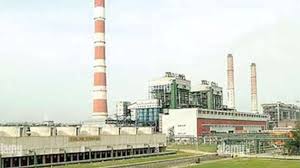
- 10 Nov 2024
In News:
- NTPC has achieved the first-ever synthesis of CO? (captured from flue gas) and hydrogen (produced via a PEM electrolyzer) into methanol at its Vindhyachal plant.
- This marks a significant step in carbon management technology, aimed at advancing sustainable fuel production.
About CO?-to-Methanol Conversion:
- Carbon Dioxide Capture:
- CO? is captured from industrial sources, such as power plants, or directly from the atmosphere.
- Hydrogen Production:
- Renewable energy sources like solar or wind power are used to produce hydrogen through water electrolysis.
- Methanol Synthesis:
- The captured CO? is combined with hydrogen in the presence of a catalyst to produce methanol, typically under high pressure and temperature conditions.
Benefits of CO?-to-Methanol Conversion:
- Carbon Capture and Utilization (CCU):
- This technology reduces the impact of CO? on the atmosphere by converting it into useful products.
- Renewable Fuel Source:
- Methanol produced through this process can be used as a fuel for transportation, power generation, or as a feedstock for chemicals.
- Energy Storage:
- Methanol offers a more practical storage and transportation option than hydrogen, making it a potential energy storage solution and aiding the transition to hydrogen-based energy systems.
- Versatile Feedstock:
- Methanol is widely used in producing chemicals, solvents, and plastics, supporting various industrial applications.
What is Methanol?
- Brief: Methanol, also known as methyl alcohol or wood alcohol, is the simplest form of alcohol. It is a clear, colorless, and flammable liquid with a distinctive odor.
- Key Properties:
- Colorless, miscible with water, toxic if ingested, flammable.
One Sun One World One Grid (OSOWOG) Initiative
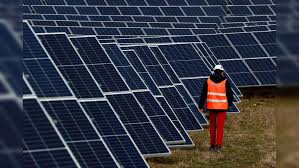
- 10 Nov 2024
In News:
- India is in talks with Oman, UAE, Saudi Arabia, Maldives, and Singapore to establish cross-border electricity transmission lines.
- This is part of the ambitious OSOWOG initiative to create a global renewable energy grid.
Key Points:
- Proposed by the Prime Minister of India at the 2018 International Solar Alliance (ISA) Assembly.
- Aims to create a transnational electricity grid that delivers power worldwide.
- Led by India and the UK, in collaboration with ISA and the World Bank Group.
Vision of OSOWOG:
- Connect regional grids through a common infrastructure for the transfer of renewable energy, focusing on solar power.
- Harness solar and other renewable energy from regions where the sun is shining and efficiently transmit it to areas of need.
- Aim to provide power to 140 countries using clean and efficient solar energy.
Phases of OSOWOG:
- Phase 1:
- Connect the Indian grid with grids in the Middle East, South Asia, and South-East Asia.
- Share solar and other renewable energy resources.
- Phase 2:
- Expand the interconnected grid to include renewable resources from Africa.
- Phase 3:
- Achieve a global interconnection aiming for 2,600 GW by 2050.
- Integrate as many countries as possible into a single renewable energy grid.
Global Collaboration:
- Involves national governments, international organizations, legislators, power operators, and experts.
- Focus on accelerating infrastructure development for a clean energy-powered world.
India's Green Leap
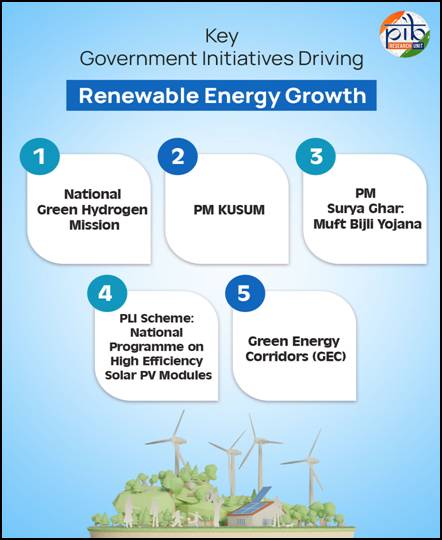
- 05 Nov 2024
In News:
India's journey toward a sustainable energy future has gained significant momentum with a series of policy reforms designed to reduce reliance on fossil fuels and accelerate the shift to clean energy. The recent Asia-Pacific Climate Report from the Asian Development Bank (ADB) highlights India's remarkable progress in reforming its fossil fuel subsidy system and its efforts to foster renewable energy, positioning the country as a leader in the region's green transformation.
Key Highlights from the Report:
India's Fossil Fuel Subsidy Reform
- India has successfully reduced fossil fuel subsidies by 85%, from a peak of $25 billion in 2013 to just $3.5 billion by 2023.
- The reform strategy is built on a "remove, target, and shift" approach, which involved phasing out subsidies on petrol and diesel from 2010 to 2014, followed by incremental tax hikes on these fuels through 2017.
- These fiscal changes created space for funding renewable energy projects, such as solar parks, electric vehicle initiatives, and infrastructure improvements.
Role of Taxation in Supporting Clean Energy
- Between 2010 and 2017, India introduced a cess on coal production and imports, which contributed significantly to funding clean energy projects. Approximately 30% of the cess was directed to the National Clean Energy and Environment Fund.
- This funding supported major renewable energy initiatives, including the National Solar Mission and Green Energy Corridor project, helping reduce the cost of utility-scale solar energy and expand off-grid renewable energy solutions.
- The introduction of the Goods and Services Tax (GST) in 2017 altered the financial landscape, redirecting the cess funds to GST compensation rather than directly to clean energy.
Government Schemes and Initiatives
- India is advancing its clean energy agenda through several key government schemes:
- National Green Hydrogen Mission: Aimed at establishing India as a leader in green hydrogen production.
- PM-KUSUM Scheme: Focused on promoting solar energy among farmers, allowing them to produce renewable power.
- PM Surya Ghar: Muft Bijli Yojana: A program designed to provide solar energy access to rural communities, reducing dependency on fossil fuels.
A Strategic Shift: From Subsidies to Clean Energy
- India’s subsidy reforms are an important part of its strategy to transition from a reliance on fossil fuels to a focus on renewable energy investments.
- These changes reflect India’s long-term goal of achieving net-zero emissions by 2070, as outlined in its climate action plans.
Global Significance of India’s Efforts
- The reduction in fossil fuel subsidies and the surge in clean energy investment serve as a model for other nations seeking to balance economic development with climate action.
- India’s approach demonstrates that policy reforms and innovative financing mechanisms can be used to accelerate the transition to a cleaner, greener economy while creating job opportunities and fostering economic growth.
